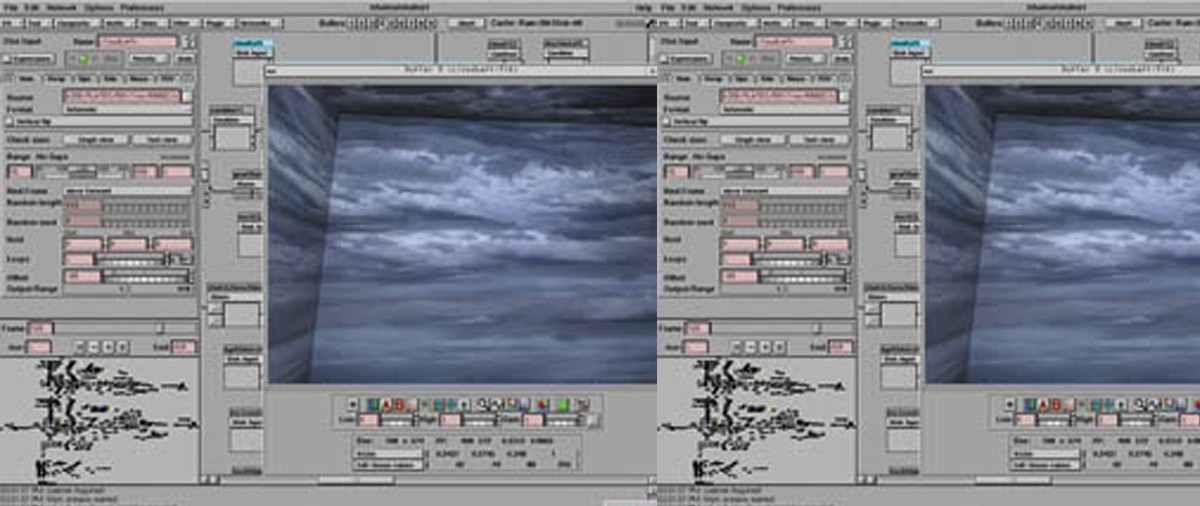Creating visual effects without Chalice is like camping without a pocket knife. Inevitably, every visual effects project requires unplanned digital image manipulation, and Chalice provides the perfect environment in which to accomplish those tasks. Silicon Grail’s latest iteration of Chalice, version 1.6, takes great strides in increasing usability while maintaining its proven underlying power. Utilitarian aspects aside, Chalice also remains an accomplished professional compositing tool.
We tested the newest release of Chalice in one of the most brutal digital environments, the compositing of 3D IMAX scenes. In about two months, we have required to composite over 1000 stereo 4k frames (2000 total output frames). Some simple math puts the size of one second of one layer at about 2.5GB, and with one 20-second shot consisting of about 20 layers, we were faced with quite a daunting task.
Our shop is built around a mixture of Wintel and SGI machines. While almost all of the heavy work was done on a dual-processor Octane and a dual-processor Origin, both with 1.5GB of RAM, some support was required from the Wintel boxes, which allowed us to investigate cross-platform issues.
The first improvement veteran Chalice animators are likely to use is the basic Sequence node functionality within the Disk Input node. As well as bouncing, looping, holding and selecting input ranges, Disk Input also allows the user to reference random frames in a sequence.
As with all improvements, there are some pitfalls to avoid. Should the user reselect a frame sequence in an already customized Disk Input (the next iteration of a rendered element for instance,) the start and endpoints will reset to the frame sequence values. Be sure to keep good compositing notes.
A seasoned compositor recognizes the importance of color in image processing. The ability to move effortlessly, or at least with a minimum of effort, between color depths is a highly valued feature. Chalice provides an excellent set of color manipulation tools. Although introduced in version 1.5, the addition of stops and printer lights layers to the Color Correction node bears mentioning here.
In film work, the most widely used image representation, Cineon, can also be one of the most difficult to understand. Chalice helps simplify the incorporation of Cineon imagery. Originally, Disk Input automatically converted Cineon 10-bit log data to fit in the first 10 bits of linear space. Silicon Grail provided a lookup table (or LUT) within the monitor, which correctly emulated the Kodak Cineon Cineview image viewer, and allowed a user to view Cineon files as they would appear when projected.
Although this method provided a lot of headroom for calculations beyond 90-percent white, the incorporation of linear data required the use of the often confusing Bit Reduce and Bit Expand nodes. Fortunately, the 1.6 users can choose to have Disk Input interpolate the 10-bit linear data to a full 16 bits.
Silicon Grail also included appropriate LUTs to support this new feature. Combining Cineon and linear data could not be easier. Of course, if the user understands the nuances of dealing with log bit data, all the familiar tools are still available.
In their continuing effort to increase the efficiency of the user interface (UI), Silicon Grail finally incorporated a set of hotkeys to ease image and sequence manipulations.
The common tasks of scaling, rotation, and translation in Xform and Rotospline not only respond to tool selection keystrokes but also support single-pixel shifts with the arrow keys. The long-awaited frame advance and frame retard keys also appear in version 1.6 of Chalice.
A seemingly simple feature, node replacement with the middle mouse button, has quickly become one of my favorite new UI functions. Future versions of Chalice would benefit greatly from the ability to switch on and off the functionality of a node within the stream.
All users should immediately benefit from the complete re-work of the Track node. In addition to a host of new interface features, the guts of the node have changed considerably. The new algorithm is faster and significantly more reliable. Along with the new Track, Silicon Grail has provided an Apply Track node to aid those not familiar with the older, more cryptic methods of incorporating track data.
I would like to finish with a word about cross-platform usability. Chalice 1.6 is extremely stable under Windows NT, but moving between platforms is still a very difficult procedure. Three major roadblocks hamper the transition. On NT, Chalice automatically changes all path component forward slashes (the Unix directory delimiter) to backslashes (the NT delimiter). To return to a Unix machine, you must manually reverse every slash.
Silicon Grail offers no mapping between Unix and NT mount points, another change which must be manually accomplished. Finally, images rendered on Intel-based machines and images on SGI machines are noticeably
different. The solution of those three issues would go a long way to fostering a true cross-platform work environment.
Aside from the specific operating system issues, version 1.6 of Chalice offers some excellent usability and performance enhancements, making it an indispensable tool for the creation of modern visual effects.
Kory Jones is a partner at Reality Check Studios and a faculty member at the American Film Institute.
